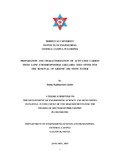Please use this identifier to cite or link to this item:
http://archive.nnl.gov.np:8080/handle/123456789/401| Title: | Preparation and characterization of activated carbon from Lapsi (Choerospondias axillaris) seed stone for the removal of arsenic (iii) from water |
| Authors: | Rajbhandari (Joshi), Rinita |
| Keywords: | Activated carbon Lapsi seed Arsenic (III) Adsorption isotherm Adsorption kinetics Pore size distribution Adsorption, |
| Issue Date: | 24-Nov-2017 |
| Abstract: | Lapsi (Choerospondias axillaris: an indigenous fruit tree of Nepal) seed stone which contains about 32.8 % fixed carbon was used as a precursor for the preparation of high surface area activated carbon. Thermogravimetric analysis (TGA) was used to monitor the course of pyrolysis. A series of activated carbons were prepared from Lapsi seed stone powder (particle size < 300 μm) by chemical activation method using zinc chloride (ZnCl2) as an activating agent under N2 atmosphere. Effect of percentage of activating agent, carbonization temperature and carbonization time on the surface area, pore structure, pore volume and adsorption capacity was systematically investigated. The ratio of Lapsi seed powder (LSP) and ZnCl2 were varied from LSP: ZnCl2 = 1:0.25 (AC – 0.25), 1: 0.50 (AC – 0.50), 1: 1 (AC – 1), 1:2 (AC-2) and 1:4 (AC – 4) and carbonization temperature from 400oC to 800oC and carbonization time from 3 hour to 6 hour. The prepared activated carbons were characterized by Fourier Transform Infrared (FTIR) spectroscopy, X-ray diffraction (XRD), Raman scattering, Scanning Electron Microscopy (SEM) and Transmission Electron Microscopy (TEM). Surface areas, pore volumes and pore size distributions were evaluated from nitrogen adsorption-desorption isotherms by Brunauer, Emmett and Teller (BET), Barrett-Joyner-Halenda (BJH), and Density Functional Theory (DFT) methods. It was found that surface area increases significantly with increasing LSP:ZnCl2 ratio from 1:0.25 to 1:0.5 and then remain apparently constant. However, total pore volume increased continuously with the LSP:ZnCl2 ratio. Increase in temperature generally improved both the surface area and pore volume but increase in the carbonization time above 4 h decreased both the surface area and pore volume due to fusion of nanoporous framework into bigger pores. Chemical characterization of the activated carbons was performed by determining iodine and methylene blue numbers. Increase in carbonization temperature increases both the iodine and methylene blue number indicating increase in nanoporosity with high adsorptive capacity of the activated carbons. Quantitative analysis of carboxylic, phenolic and lactones functional groups was determined by the Boehm titration. SEM observations showed highly porous surface structure of the activated carbons. XRD patterns exhibited broad peaks at diffraction angles 25 and 43 degrees corresponding to the (002) and (001) planes of graphitic clusters. These broad peaks are the indication the amorphous structure of the prepared activated carbons, which is further supported by Raman Scattering Spectra where two broad bands approximately at 1345 cm-1 (D band) and 1588 cm-1 (G band) were observed. Thus the activated carbon prepared from Lapsi is amorphous materials having nanoporous (microporous and mesoporous) structures. Activate carbon prepare with LSP to ZnCl2 ratio 1:1, carbonized at 400oC for 4 hour (AC-1) as the optimum condition on the basis of economic reason and with reasonably high BET surface area, pore volume, Iodine number and Methylene blue Number was selected for iron impregnation for the adsorption of arsenic. The iron impregnation was carried by chemical precipitation method and the content of iron was examined using FTIR, XRD, Raman Scattering Spectroscopy and SEM. The batch adsorption studies of As (III) were carried out with iron impregnated activated carbon (AC-1/Fe) and the effect of pH, adsorption dose and contact time on the efficiency of As (III) adsorption was investigated. Iron impregnated nanoporous carbon showed excellent arsenic adsorption capacity and could decrease arsenic content in water from 800 ppb to below 50 ppb. Maximum adsorption of 95.9% was achieved at pH > 6. The optimum conditions for adsorbent dose were calculated to 2g/L at pH 6. The adsorption of arsenic progressively increased with time and reached equilibrium in about 120 minutes. The adsorption equilibrium data of As (III) better fitted with Langmuir isotherm than with Freundlich isotherm. The maximum adsorption capacity was found to be 2 mg/g. The adsorption free energy, ΔGo was calculated to be – 32.2 kJ mol-1. The separation factor RL was found to be 0.772, which shows the favorability of the adsorption isotherm. The kinetic data better fitted the Lagergren pseudo second order kinetics. |
| Description: | A Thesis submitted to the Department of Engineering Science and Humanities in Partial Fulfillment of the requirements for the Degree of Doctor of Philosophy in Chemistry, Department of Engineering Science and Humanities, Central Campus Lalitpur, Nepal, 2015 |
| URI: | http://103.69.125.248:8080/xmlui/handle/123456789/401 |
| Appears in Collections: | 600 Technology (Applied sciences) |
Files in This Item:
| File | Description | Size | Format | |
|---|---|---|---|---|
| Rinita PhD Thesis (final).pdf | 4 MB | Adobe PDF |  View/Open |
Items in DSpace are protected by copyright, with all rights reserved, unless otherwise indicated.